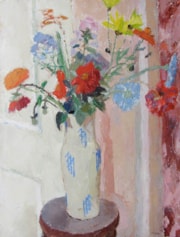back@using System.Web;

Sir William George Gillies, CBE, LLD, RSA, PPRSW, RA
(1898 - 1973)
Sir William George Gillies was born in Haddington, East Lothian and studied at Edinburgh College of Art. Following his graduation he taught there for 40 years serving as principle from 1959 until his retirement in 1966. As such, and apart from his own vision and prowess as an artist, there can be few people who have had such a profound effect on 20th century Scottish Art.
Gillies graduated in 1922, and along with fellow graduates of that year William MacTaggart (1903-1981) and William Crozier (1893-1930), founded the 1922 Group, a society whose work was exhibited at the New Gallery on Shandwick Place until the early 1930s. Having achieved a travelling scholarship, Gillies went to Paris in 1923 where he studied under André Lhote (1885-1962) at the same time absorbing Fauvist and Cubist practices from artists including Henri Matisse (1869-1954), Edvard Munch (1863-1944) and Georges Braque (1882-1963).
Following a brief tour of Italy in 1924 Gillies returned to Scotland, teaching in Inverness for a year before taking up his post in Edinburgh on a part-time basis from 1926. Having concentrated on portraiture in his early career Gillies was, by the late 1920s, using a structured style and earthy palette, to paint the still lifes and landscapes which would define his oeuvre. In 1939 he and his family moved to Temple in Midlothian, the surrounding landscape providing ample inspiration.
Gillies had an extraordinary work ethic with rarely a day passing where he did not do some form of painting or drawing. Like his compatriots in the Edinburgh School and to a degree the Colourists, Gillies strived to translate reality and form onto canvas as truthfully as possible while at the same conveying a particular mood or atmosphere. His willingness to accept and discover new artists and art forms was key to the development of his own style, but probably had a greater effect on his abilities as a teacher.
Along with numerous successful exhibitions Gillies’ contribution to British art was first recognised in 1957 when he was awarded the CBE. Rather than slowing down, his retirement from the Edinburgh College of Art prompted a resurgence in his work. He was knighted in 1970.
His works can be found in museums in: Aberdeen Art Gallery; Dundee, The McManus Gallery; Edinburgh, The National Gallery of Scotland; The Royal Scottish Academy; The Scottish National Gallery of Modern Art and Paisley Museum and Art Gallery.
Gillies graduated in 1922, and along with fellow graduates of that year William MacTaggart (1903-1981) and William Crozier (1893-1930), founded the 1922 Group, a society whose work was exhibited at the New Gallery on Shandwick Place until the early 1930s. Having achieved a travelling scholarship, Gillies went to Paris in 1923 where he studied under André Lhote (1885-1962) at the same time absorbing Fauvist and Cubist practices from artists including Henri Matisse (1869-1954), Edvard Munch (1863-1944) and Georges Braque (1882-1963).
Following a brief tour of Italy in 1924 Gillies returned to Scotland, teaching in Inverness for a year before taking up his post in Edinburgh on a part-time basis from 1926. Having concentrated on portraiture in his early career Gillies was, by the late 1920s, using a structured style and earthy palette, to paint the still lifes and landscapes which would define his oeuvre. In 1939 he and his family moved to Temple in Midlothian, the surrounding landscape providing ample inspiration.
Gillies had an extraordinary work ethic with rarely a day passing where he did not do some form of painting or drawing. Like his compatriots in the Edinburgh School and to a degree the Colourists, Gillies strived to translate reality and form onto canvas as truthfully as possible while at the same conveying a particular mood or atmosphere. His willingness to accept and discover new artists and art forms was key to the development of his own style, but probably had a greater effect on his abilities as a teacher.
Along with numerous successful exhibitions Gillies’ contribution to British art was first recognised in 1957 when he was awarded the CBE. Rather than slowing down, his retirement from the Edinburgh College of Art prompted a resurgence in his work. He was knighted in 1970.
His works can be found in museums in: Aberdeen Art Gallery; Dundee, The McManus Gallery; Edinburgh, The National Gallery of Scotland; The Royal Scottish Academy; The Scottish National Gallery of Modern Art and Paisley Museum and Art Gallery.

